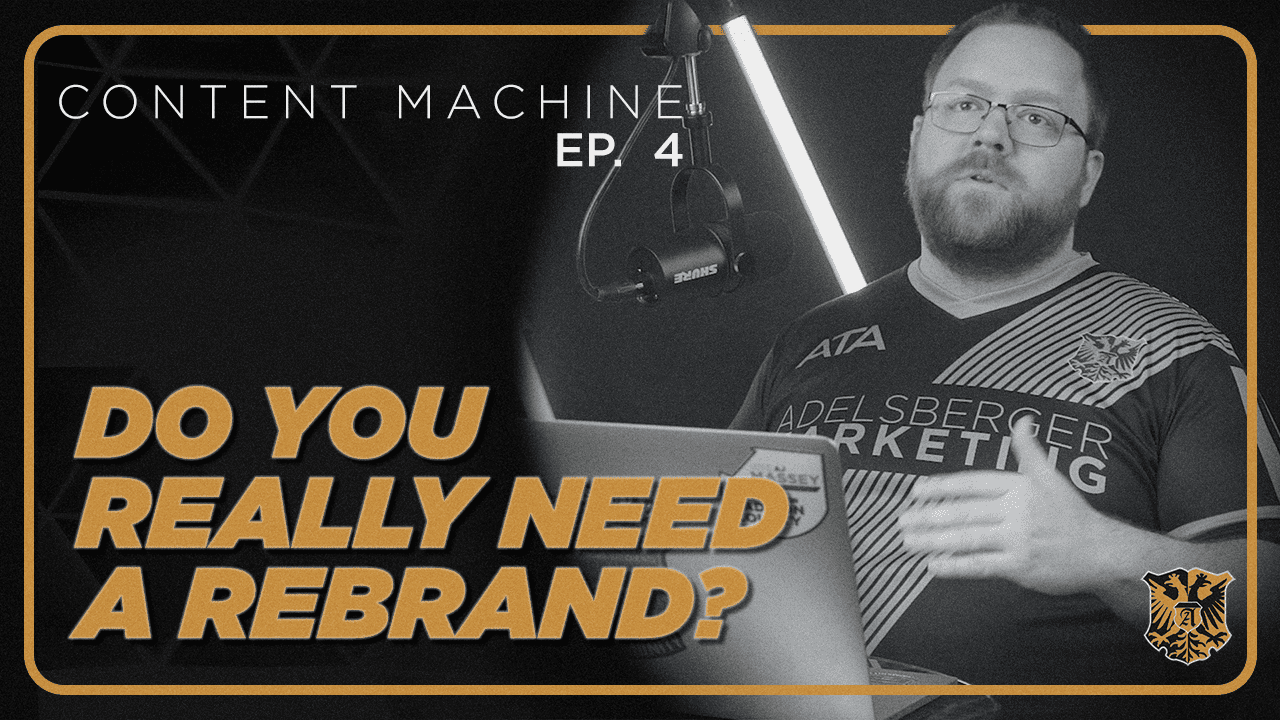
A question we get regularly is should we rebrand? And my first answer to this question is usually no. And now I try to deliver that gently because it’s not what people expect me to say. Don’t get me wrong, rebrands can be fun projects and profitable, but most people don’t think about it the right way. First question we need to explore is are they wanting to simply renovate their logo, change their logo altogether, or change their name and their logo?
Rebranding in people’s minds can mean any of these three things. Of course, branding is way more important than just the logo on your website. But this is what people think of when they say rebrand. So why am I so cautious of a rebrand? Well, there’s three main reasons trust cost, physical cost and promotional costs.
The main purpose of having a consistent brand is to build trust in your current and potential customers. Trust that you are a business to work with, that you will do the job, and that you are safe to do business with. And while this is difficult to measure, when you change your brand, your logo or your name, you are hurting the recognition ability of the current and potential customers in your world. This symbol of your company or this name is what people have grown accustomed to. And if that’s removed, you are losing brand value.
With these folks, this can be difficult to rebuild, but I find people do not really consider the value they will lose on a rebrand. It is difficult to measure, but there are reasons major corporations spend so much money on brand advertising. The second thing I think people should consider is the physical cost of the rebrand. If you go through a logo or a name change, you’re going to have to update many things more than you can think of at this moment. Letterhead, business cards, signage, company culture points.
This stuff adds up when you budget for a name change. Don’t only consider the cost of engaging the agency to help with the design, but also consider the literal physical cost of the change and the timeline that that might add to the project. Regardless of how easy it is to change your Facebook avatar, building exterior signage does not show up overnight and it is not cheap. And finally, some people view a logo or a name change as a reason to do a bunch of promotion. Why?
Well, you have to rebuild the brand trust that you just lost and help educate consumers on the change. But here’s the cold, hard truth while you are excited about your rebrand, the general public probably does not care. Some of your customers might be interested, but largely folks don’t care unless you are changing your ownership or service offerings. That leads me to why might you rebrand? There are several bad reasons to rebrand, but there are some good ones.
Number one, your brand has suffered something tragic and it’s leaving a bad taste in people’s mouths. Maybe your brand or ownership did something really dumb and public like rip off all of your customers in the past. Or you were named with a racially insensitive name. These are good reasons to move to a rebrand. The trust or good feelings you are trying to build are being hurt by your current brand.
If your company heads in a new direction, a really new direction, it might be time for a rebrand in a new direction. I mean, do you change your service listings? Did you make a big pivot? Like, were you a traditional mechanic and now you are a mobile oil change service? Were you making one type of widget?
And now we’re making a very different type of widget. Did ownership change? Did you go from being an independent startup to being part of a bigger corporate structure? But note that some corporations might want to buy a smaller company because of the brand value alone. And sometimes your logo is truly outdated.
Outdated really comes in in two categories in my view. One, your logo was extremely trendy when it came out and each year has its own logo and design trends. If you go too trendy with the logo, you might be looking at something that is outdated. In a few years, this could hurt your brand by making you feel out of touch with the times. The other major category here is that your logo is not usable.
When we mean usable in our current era, your logo has to work in a lot more places than it did ten years ago. Does your logo have something that will work as a favicon in a browser? Will it work on a mobile app? Will it also work on a billboard? The change of placement opportunities have rendered some logo designs obsolete.
Sometimes a whole rebrand of a name and a logo is not necessary because you can fix some of the problems with a few other techniques. Number one, if your company is starting to stray from what you wanted it to instill in its customers, look at your core value and missions. Do they exist? Are you properly leaning on them to run the company? Does the team know if they are important?
This can help make sure that the company backs up the ideals that you are pushing the brand to show. Additionally, can you change how your marketing is being displayed to the outside world? Maybe that involves talking about other components of your business or having more diverse imagery in your marketing, or focusing on company charity work. What if you took the total cost of the rebrand, physical cost, design cost, promotional costs and invested that into the storytelling of the story that you want to be said about your company, or investing it in the community to generate goodwill? If your logo is out of date or unusable, you will want to consider a logo update.
But let’s call it a logo renovation. For this purpose, a logo renovation should keep the core symbolism or elements and put them in a way that works better in our modern era. Keeping essential parts can help retain the trust built with the logo and make it easier moving forward. Finally, make sure your marketing oneliner your short one sentence description of the business lines up with what you want your brand to be. This is far easier to change than a logo and can help the entire company to be rowing in the same direction when they talk about your brand.
I hope you don’t need a rebrand, but hopefully your marketing partner will help you consider whether it is a good idea or not when you call instead of just saying yes. Thank you for listening. If you found this podcast helpful, text it to a friend who might be considering a rebrand.




